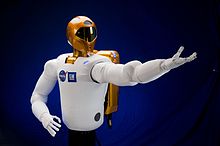Robonaut

A Robonaut ( Robotic Astronaut ) is a humanoid robot developed by NASA and the Defense Advanced Research Projects Agency (DARPA) for extra-vehicular activity , i.e. H. Outboard activities during space flights or at space stations ( ISS ). The name Robonaut is a suitcase word from Robotic ( robotics ) and Astronaut .
The Robonaut was developed in collaboration between NASA and the Defense Advanced Research Projects Agency at the Johnson Space Center . The aim was to develop a robot that, during outboard activities in space (for example on a space shuttle - RMS attached to the outer shell for repairs) has the same or even better capabilities than a human astronaut.
There are several models of this robot. Some are provided with different drive means, such as a Segway platform on four wheels. These ground-based robonauts are developed for missions on planetary surfaces. The robot can be controlled via telepresence and also has different levels of autonomous intelligence (robotic autonomy). A robot hand has 14 degrees of freedom and tactile sensors on the fingers.
Robonaut 2 (R2)
The Robonaut 2 , jointly developed by NASA and General Motors , started in February 2011 with the STS-133 mission of the Space Shuttle Discovery to the International Space Station . With his human-like hands he is supposed to use the same tools as the human ISS crew. The Robonaut 2 has a modular structure so that the arms, the "head" or the torso can be exchanged. After arriving at the ISS, a series of tests should first be carried out, after which the Robonaut is gradually modified by replacing individual modules. After it is first permanently installed on a base, legs are to be added in this way for locomotion in the station. Later, Robonaut 2 is to be enabled for spacecraft missions in the same way.
The Robonaut 2 has cameras and based on the underlying image analysis it can independently decide which actions are to be carried out. The complex image processing required for this was implemented by NASA with the German software library for image processing HALCON from MVTec Software. This image processing software converts what has been seen into motor skills commands in real time. The Robonaut 2 is able to enter text into a mobile phone, recognize and operate switches, and pick up and use tools. The Robonaut 2 can therefore take over work independently, for example outside the space station. There it should actually be used to relieve the astronauts.
Project M
NASA's "Project M" was a concept that saw a legged version of the Robonaut 2 land on the moon in 2013 . The main aim of the mission would have been to demonstrate the YEA technology. In addition to the robonaut, the moon lander should also use new technology. However, these plans were not implemented.
Technical publications
- RO Ambrose, H. Aldridge, RS Askew, R. Burridge, W. Bluethman, MA Diftler, C. Lovchik, D. Magruder, F. Rehnmark: ROBONAUT: NASA's Space Humanoid , IEEE Intelligent Systems Journal, Vol. 15 , No. 4, pp. 57-63, July / Aug. 2000, doi : 10.1109 / 5254.867913 .
- MA Diftler, CJ Culbert, and RO Ambrose: Evolution of the NASA / DARPA Robonaut Control System . In: IEEE International Conf. Robotics Automation , pp. 2543-2548, 2003.
- G. Landis: Teleoperation from Mars Orbit: A Proposal for Human Exploration In: Acta Astronautica, Vol. 61, No. 1, Jan. 2008, pp. 59-65; IAC-04-IAA.3.7.2.05, 55th International Astronautical Federation Congress (2004).
See also
- Justin (robot) - humanoid robot from the German Aerospace Center
- Cimon (robot) - free-flying robot on the ISS
- Skybot F-850 - humanoid robot from Roskosmos
Web links
- NASA: Robonaut home page (English)
- NASAtelevision - Robonaut 2 Joins ISS Crew ( YouTube video, March 18, 2011, English)
- Website about the HALCON software used (English)
Individual evidence
- ↑ http://robonaut.jsc.nasa.gov/ .
- ↑ USA Today, Rise of Robots , Oct. 20, 2004.
- ↑ https://www.heise.de/tp/artikel/18/18079/1.html .
- ↑ http://er.jsc.nasa.gov/SEH/Robotics/index.html .
- ^ MK O'Malley and RO Ambrose, Haptic feedback applications for Robonaut . In: Industrial Robot: An International Journal, Vol. 30, pp. 531-542 (2003) doi : 10.1108 / 01439910310506800 .
- ↑ https://www.youtube.com/watch?v=lY-SJyS18lA .
- ↑ http://www.golem.de/1004/74559.html .
- ↑ Netzwelt from April 15, 2010 .
- ↑ - ( Memento of the original from September 24, 2015 in the Internet Archive ) Info: The archive link was inserted automatically and has not yet been checked. Please check the original and archive link according to the instructions and then remove this notice. .
- ↑ Archive link ( Memento from May 27, 2010 in the Internet Archive )
- ↑ http://www.golem.de/1007/76229.html .

